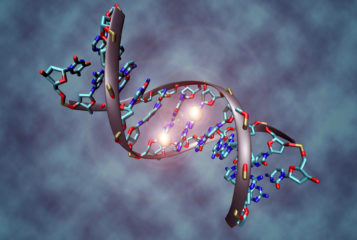|
Gene Regulation and the Epigenome Organised by the Royal Society Royal Society, 6-9 Carlton House Terrace, London SW1Y 5AG Wednesday 2 December 2014 |
The 2015 Francis Crick Prize winner Professor Rob Klose wants to explain to you how 'this beast called the epigenome' contributes to the control of our genetic information. If you'd like to learn more about epigenetics (literally meaning 'over genetics'), or just watch a masterly science presenter at work, then I'd recommend you head to the Royal Society's webpage.
The hour-long public lecture on epigenetics is a fast-paced, fascinating journey through the exciting field of epigenetics by one of the field's leading researchers. Since 2008, Professor Klose has been heading a laboratory group as a Wellcome Trust research fellow in Oxford University's Department of Biochemistry.
Professor Klose uses the first half of the lecture to outline key epigenetic concepts, before describing his own team's experiments and findings. He's a natural communicator, able to make complex science accessible and even cracking the odd joke.
Addressing his audience members in a familiar and engaging way, he opens with the start of life, describing 'in not-too-graphic detail' the fusion of your parent's gametes. This leads him quickly into the discovery of DNA, and how the cell uses transcriptional machinery to code active proteins from inert DNA. Specialised proteins called enzymes carry out processes which 'help our cells to come alive'.
A fertilised egg is essentially a blueprint. But it needs to divide into many cells – ultimately developing into over 200 different cell types to form a human being. All of these cells types are totally different in shape and function. How are they all so different when they all contain the same information? The answer is that they use a defined subset of the 25,000 protein-coding genes in the genome – and this is where epigenetics comes into play.
First, Professor Klose tells us about gene-regulatory elements, which are different from protein-coding genes. They contain a short DNA region which is recognised by a transcription factor. This tells polymerase ('a rather dumb enzyme') whether to engage with DNA, and this controls whether a gene is expressed or not.
Inside the cell, DNA is wrapped like a spool of thread around histones to form nucleosomes, which make up chromatin, a packaging structure which forms chromosomes. This packaging effectively locks down the library, limiting access – unless certain epigenetic tags are present to dictate access. These epigenetic tags make up the epigenome.
These are some advanced concepts, and Professor Klose is careful to define scientific words, so 'express' becomes 'just a fancy way of saying use'. He also uses slides with simple diagrams to illustrate his points.
Professor Klose wants to understand how it is that epigenetic modifications help to control how gene regulators and genes are used in our vast genomes. If you perturb epigenetic systems this can have profound effects, including cancer and even inherited diseases.
The problem is that we don't fully understand how epigenetic landscapes are set up in the first place, and how they affect gene regulators. These are the two central questions his lab seeks to address.
He explains methylation – a broad-brush silencing mechanism. Non-methylated C bases tend to be found in dense 'CpG island' regions near gene-regulatory elements. Two thirds of our genes are associated with a CpG island yet 'we understand little, if anything, about what they're doing in the genome'.
The group looked to find out if proteins could recognise, bind to and influence the functionality of the CpG islands. They conducted a chromatin immunoprecipitation experiment, using 'a special sort of molecular glue', 'a pair of molecular scissors' and a 'molecular magnet' (who knew science involved so much arts and crafts?) to pull the protein they're interested in away from the rest of the genome to analyse it.
Professor Klose takes the audience through some of his experimental data to show that an enzyme, KDM2A, resides at the same sites as the CpG island. His team's experiments confirm that KDM2A highlights 'landing sites' in chromatin so that the transcriptional machinery can focus its efforts on transcribing active genes.
Professor Klose outlines his key experimental procedures, which he calls 'simple minded', although many audience members may disagree! In fact, many of these experiments are too technically challenging to do inside animals, only possible in cells in petri dishes.
However, they do look at the epigenetics of a developing mammal – a laboratory mouse. They removed both of the mouse's copies of another epigenetic enzyme, KDM2B. The mouse develops as an essentially amorphous blob – an embryo with no specialised tissues. This illustrates how the systems that regulate CpG islands are needed to turn on the right genes at the right time in development.
Professor Klose again modestly insists his experiments are 'rudimentary' in nature because at this stage they merely perturb systems and make observations. He concludes by stating that in the next five to ten years he thinks he and others will be able to investigate the biochemistry of various epigenetic systems, combining basic biology with new therapies to target epigenome-related pathologies. Indeed, he mentions that several epigenetic drugs are already in human clinical trials – although it is a slight shame that this exciting aspect doesn't get more than a mention.
No matter your level of science background, you'll enjoy watching Professors Klose's modest but powerful lecture. By the end, I can't help but think that soon there will be an epigenetic revolution to rival the genetic revolution kick-started by Watson and Crick over 60 years ago. What could be a more fitting subject for the Royal Society's Crick prize?






Leave a Reply
You must be logged in to post a comment.